Meredith R. Stoddard's Blog, page 8
May 24, 2016
Tweeting Success: Life of the Party
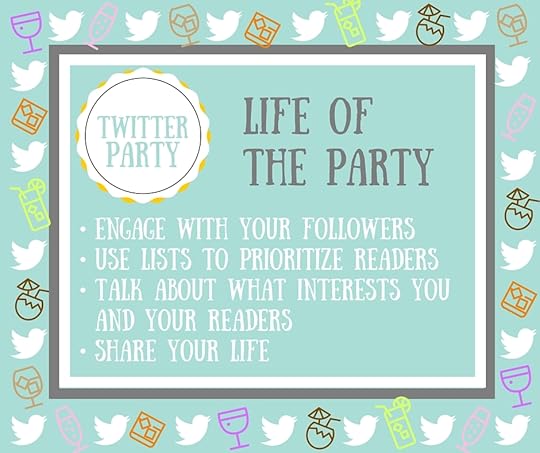
Let's return to our virtual cocktail party that is Twitter in which you are looking to connect with readers. Now we've already talked about branching out and finding readers rather than just hanging with other writers. We've also spent a post identifying potential party fouls. So, this time I'd like to talk about how to engage effectively with readers on Twitter.
As I've mentioned before, you want to treat Twitter like a cocktail party. So, only talking about yourself all the time, is not a great way to build relationships. And make no mistake, relationships are what you want. Sure you can tweet out a link to your book, and you might even get someone to click on it. But you'll get far more traction by forming a relationship with a reader who will buy your next book when it comes out and recommend you to other readers. Relationships make FANS and fans act as street teams to spread the word when you release a new book, or have an event.
Engage with your followersWhen you're trying to make friends with someone at a party, you don't just walk up to them and start talking about yourself non-stop. You tell them a bit about yourself, and they tell you a bit about themselves. You look for common ground. Twitter should work the same way. See what your followers are talking about an talk with them. Find that common ground. Maybe you like the same authors, or have the same hobbies. Maybe you have vacationed in the same spots. Look for common ground and start conversations. They don't have to be long in-depth conversations. You are limited to 140 characters. They just have to be friendly.
Use lists to prioritize readersNow, if you're following a lot of people on Twitter, you might need to find a way to narrow down who you are following so you can know who to engage. Fortunately, Twitter lets you make lists based on whatever category you like. It's like a personal way of categorizing and tracking all of the people that you meet at the party. I keep lists based on a number of things.
I have a list of the "Best readers in the world" (Mine, of course). Whenever someone tweets to me that they enjoyed something that I write, I add them to the list. This way I can view the list and see what my readers are talking about and what's going on with them. I can also engage with them whenever I see a common interest or when they have news. I can congratulate them on an achievement, coo at pics of their babies, or tell them that I also loved the other author that they just tweeted about.
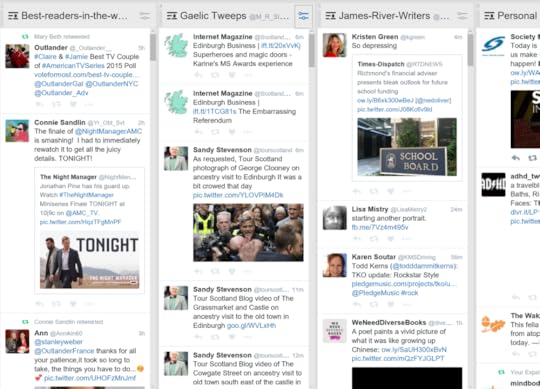
Tweetdeck lets you create columns with your lists to streamline your feed by topic.
I also keep lists for things that I am interested in and/or my readers are interested in. I'm learning Gaelic, and many of my readers are Scotia-philes, so I have a list of accounts that tweet in Gaelic or about Scottish issues. If I see something that will interest my readers, I retweet it. I have a list of author friends, who I try to engage with. If they're having events that I think will interest my readers, I will spread the word. This helps cut through the noise and build engagement. I highly recommend using a tool like Tweetdeck that lets you see multiple lists at once in columns across your screen.
Talk about what interests you and your readersAs I said before you are looking to find common ground. So, talk about what interests your readers especially if it relates to your books. I've already mentioned Gaelic. I also like to tweet about Scotland and Scottish history, and folklore. Most likely, these folks chose your book from the millions available to read, because something about it interested them. Which means that common ground shouldn't be too hard to find.
Your readers are probably also interested in your process and the things that inspire you. Tweet that! I like to share songs that I listen to while writing, articles and books that I use to research (if you can do this without spoiling things), and pictures of the settings for my books (again, if you can without spoilers).
Share your lifeReaders like to feel connected to you. They like to see things about your life. I'm not saying that you should tweet a picture of every meal you eat or your family's dirty laundry. Share what you're willing to share. For example, I have three cats with big personalities. So, I like to share pictures of my cats when they do something especially adorable. I didn't think much of it, until I met a reader and she asked me how my cat, who had recently had a health scare was. That's relationship building. If you visit someplace interesting, tweet it. If you watched something great, tweet about it.
Tweeting really isn't hard. You can engage readers, and build relationships the same way that you make friends at a party. Be friendly and engaging. Don't take things too seriously and don't be afraid to laugh at yourself. Be as interested in them as you want them to be in you. So when you DO tweet out a link to your book because you've got a new review, or won an award, or release another, they will help you spread the word.
May 13, 2016
The Impostors
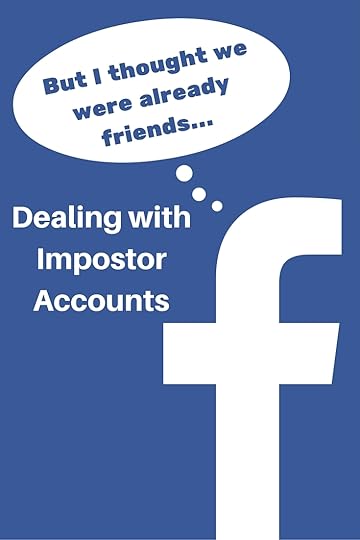
I know I'm frequently talking about Twitter, but this time, I wanted to give everyone a little PSA about Facebook. Odds are if you've been on Facebook for more than a month or so you've had this happen to you.
You get a friend request from someone that you could just swear you're already friends with. On the surface this account looks like your friend's. It's got his/her picture, and name, and might even have already roped in some mutual friends. Maybe even a couple of extra snapshots. But that's where the similarities end.
What you've got is an impostor account. Scammers create impostor accounts for two reasons:
They're phishing. You can set your privacy settings to only show your posts and information to your friends. Pretending to be your friend is the impostor's way of getting around that. By mistakenly accepting their request (thinking that you know them), you are granting them access to all that information that you meant to keep private.They are going to ask you for money. These will give themselves away pretty quickly, because they will likely send you a message after you accept their request. "Hey, how have you been?" And you, believing that they are your friend, respond. Eventually, they will work the conversation around to some story about how they really could use a little money because they are having trouble making ends meet, just got hit with a sudden expensive car repair/medical expense, their nephew needs bail money...Hopefully, you're not gullible enough to fall for this, but I'm sure there are some folks out there who are.The thing about impostor accounts, is that they are hard to prevent and hard to keep up with. Just about anyone can create a Facebook account with any name they want. And because we post pictures where anyone can see them, people can download those pictures and use them for their own purposes. The internet is full of stories of unsuspecting people whose images and even video have been coopted for other people's purposes. They get made into memes, used as before or after pictures in shady internet ads and even used in YouTube videos (anyone remember Techno Viking?). The scammers who create impostor accounts don't need your password. They don't hack into your account. They just copy it.
Facebook is supposed to police this, and they do to some extent. But they can't catch or keep up with all of them without our help. So, if you get one of these friend requests, DON'T IGNORE IT. The thing about social media is that it's a community. Would you walk past a mugging in process and not do anything? Would you watch someone walk through a crowd of your friends and pick their pockets without stopping it or reporting it? The only way to stop impostors is for those of us who use social media for legitimate reasons to behave like the good citizens that we are by reporting the scammers whenever we see them.
Luckily for us, Facebook has a protocol for reporting exactly this kind of thing. It only takes a few clicks, but it can stop a scammer in their tracks. Of course, not everyone uses all the features on Facebook. Many people don't even know these things are there. So, I've made a handy infographic to walk you through the steps. (See all those years as an instructional designer are good for something ;)
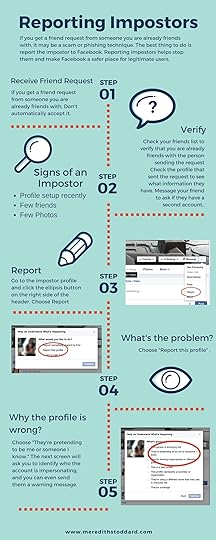
March 26, 2016
Tweeting Success: Party Fouls
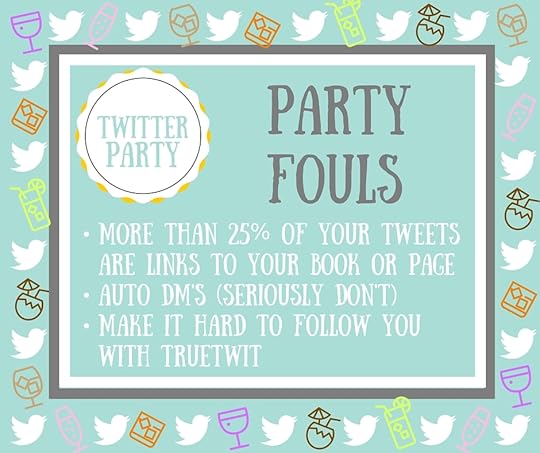
Tweeting Success: Starting off Right
In my last post on Tweeting Success, we talked about building your following. I suggested that you treat Twitter like a great big cocktail party. So, you and your author friends have split up to mingle with whatever readers you can find. You have pointed your pinchy shoes toward a cluster of potential readers and have decided to introduce yourself. Before you get going we should talk a bit about some DON’Ts of Twitter behavior.
The simple prescription is to be yourself, and behave as you would if you were actually face to face with people at a cocktail party. It’s up to you to decide what topics you’re comfortable with and what you’re not. If you’re a person who likes to talk politics or religion or fashion, have at it. But remember those are people (mostly) on the other side of that tweet. So the general rule is don’t say anything that you would be embarrassed to say to a person’s face or a group people at a party.
What I want to call out in this article is some party fouls you might see on Twitter. If people did these things in real life they would range from annoying, to off-putting, to straight up weird.
SpammingImagine that you are standing drink in hand in front of a whole new group of people. You’ve just started a conversation with a likely candidate. As you’re talking about your shared interest in maritime history, another author walks up wearing a sandwich board and waving a copy of her book at anyone glances her way. Everyone who encounters sandwich board writer rolls their eyes. As groups they close ranks and exclude her from their conversations.
This is the real life equivalent of the spammer, that is a writer on Twitter who tweets nothing but self-promotion. I’m talking about more than 25% of their tweets contain links to their book listing, their Author Central page or their Facebook page. All they seem to say is “buy my book”, “like my page”, “follow me”. These tweets don’t add value to the conversation, and people will pay even less attention to them than they do to the wait staff silently handing out drinks. At least the staff will occasionally garner a “Thank you”. Spammers get unfollowed quickly, or they are simply ignored.
Are there times when it’s okay to tweet links to your books? Yes. When you have news, tweet a link.
Running a countdown deal or free promoJust got a great reviewArticle in the media about you or your bookWon an awardGave an interviewHave an event like a book signingAll of these are good excuses to tweet about your book, within reason. Stick to the no more than 25% rule and you should be fine.
Direct MessagesWhere your tweets are public and anyone can see them, direct messages are private. In order to send a direct message to someone, you have to be following them and they have to be following you. In real life, it would be a bit like whispering in someone’s ear. That’s all fine between friends, but would you whisper in the ear of someone you just met in the middle of a cocktail party? More to the point, would you whisper, “Nice to meet you. You might like my book. Here’s a link to buy it.” or “Nice to meet you. You should like my Facebook page.” to someone you just met? I sure wouldn’t.
But I see that sort of thing on Twitter all the time. “Thanks for following me. Here’s a link to my free ebook.” Or even just a “Thanks for the follow.” In fact, there are services like Crowdfire and Commun.it offer features that will send these messages automatically. This is the Twitter equivalent of junk mail, and it is possibly the most widely hated behavior on Twitter.
But you don’t have to take my word for it. There are numerous articles from blogging and marketing professionals confirming just how hated this behavior is. You can read some here, and here, and here. I’m sure you could turn up a dozen more with a quick Google search. Why do people hate DM’s so much?
Well, in the days of smartphones our near Pavlovian response to message notifications, imagine that your phone suddenly starts to ding you. Could that be a text from the girl you met the other night? An important text from one of your kids? Email from your day job? Nope, it’s an utterly pointless impersonal and unsolicited message from someone you just followed on Twitter. Just like email spam, these messages fill up our mailboxes and prevent us from seeing real personal messages from actual people that we know, and Twitter doesn’t have a spam filter for DMs to prevent that.
So do yourself a favor and whisper in people’s ears on Twitter if you know them, or you really do have something private to tell them.
TrueTwit ValidationAs weird as whispering in the ear of someone you just met sounds, there is something even more socially inept that people do on Twitter. Imagine that you see someone admiring the artwork at the party. You like the painting too, so you think to strike up a conversation. You walk up and introduce yourself, but before this new person will talk to you, he asks you prove you are in fact a human and not an android.
That’s right. It’s like asking every person you meet to show you their driver’s license. But a shocking amount of people (certainly not you) on Twitter do this through a service called TrueTwit. You’ve probably gotten their auto-DMs, “So-and-so uses TrueTwit validation. To validate click here:”. Now, if you’re trying to build your audience and reach new readers, is it very welcoming to ask them to prove that they’re people?
TrueTwit sells itself as a way to prevent spam by preventing bots from following you. Bots are accounts that exist specifically to tweet ads or retweet items of interest on a particular subject. We’ll come back to those in another post, because they can actually be useful. Remember, followers are the people listening to you. That doesn’t mean that you have to be listening to them. So by using TrueTwit, you’re asking someone to click multiple times just for privilege of listening to what you’re saying. Who besides someone who already knows you is going to do that? Also, some of the worst offenders in the world of Twitter spam, aren’t bots at all (See item 1 above).
If you’re following someone who sends spam, unfollow them. It’s not hard. If someone looks like a bot or a spammer don’t follow them. But alienating people by both sending a much-hated auto-DM AND asking them to prove that they’re real isn’t going to build your platform.
Let’s recap on our ways to avoid Twitter party fouls:
Use your best cocktail party manners.Focus on engaging with readers rather than spamming Twitter with links to your books.Only send Direct Messages if you have something to say to a user that should be private between the two of you.Be accessible by making it easy to follow you.
February 24, 2016
So, about that Google Translate for Scots Gaelic

I should start by saying that it’s GREAT that Google Translate added Scots Gaelic to its list of languages. Seriously! At a time when Gaelic speakers/learners are fighting to save the language, or sometimes just convince people that it’s a living language and not a historical artifact it’s a big step forward to have Google deem it worth the programming needed to create something like this. And that’s A LOT of programming. Rosetta Stone hasn’t felt that it was worthwhile to offer their software in Gaelic, they even dropped their Welsh program years ago. So, should you add Google Translate to your list of Gaelic learning resources, use it to translate some key phrases for that great highland romance novel you’re writing, translate a favorite motto of yours for a Gaelic tattoo? Not so fast.
Online translators like Google’s are fine for getting a basic translation, but there are limitations. You can build a translation database out of rules, and existing translations, but that doesn’t account for exceptions, idioms, metaphors, dialects…There are so many variables and nuances with any language that it’s almost impossible to account for them all. Here is an article with more specifics about how translators work and their limitations.
So, I decided to test out Google’s new Gaelic translator and see just how good it is. Disclaimer: I am not a native speaker and am still learning, so I’m not an expert. But I do have plenty of experience testing software. I have even written a software quality assurance plan. I kept my tests pretty simple. No compound sentences or anything tricky. I wasn’t trying to trip it up. I’ll leave that to speakers with more knowledge and experience. I was just curious how it handled certain aspects of the language, namely those that most different from English. Here’s what I found.
Battling IdiomsIn English, when we meet someone we are likely to say, “It’s nice to meet you”. Sometimes we might say, “I’m pleased to meet you”, however that more formal expression seems to be falling out of use. In Gaelic, it’s the norm. We would say, Tha mi toilichte ur coinneachadh (I am please to meet you.) Most Americans looking for a translation would probably be more likely to put “It’s nice to meet you” into the translator. The trouble with that is two fold. First it doesn’t include that emotion “pleased”. Also, Gaelic uses gendered pronouns. There really isn’t a pronoun for it To fit with non-gendered pronouns from other languages, it sometimes defaults to the male pronoun. However that changes the subject of the sentence of the sentence. The translation below literally means, He/It is good meeting to you. That’s not exactly wrong. But it’s not something you would say in Gaelic.

Sentence structure
Most basic English sentences begin with the subject, usually a noun: I like cheese. Dave plays baseball…But in Gaelic, most sentences start with the verb that is often followed by the subject. If I want to say, “I have a cat” I would say Tha cat agam, which literally translates to “A cat is at me.” I tried this in Google Translate going from English to Gaelic and I got Tha mi cat, which is bad grammar but closer to “I am a cat.” than it is to “I have a cat.”

When I put the correct Gaelic into the translator, it worked fine.

Possessives
While Gaelic has possessive words like mine and yours, it’s more common to use a prepositional pronoun to link things to people. In Gaelic things, people, feelings are “at you”, “on you”, or “with you”. Hence phrases like the familiar Tha goal agam ort. (The love that I have is upon you.).
If you put “My” into Google Translate in just about any context it’s going to return mo. That’s not necessarily wrong, but as I said, it’s more common to say an cat agam (the cat at me). On any of these results, you can click the translation results and see other options. Sometimes the more accurate answer is in there. In this case when I clicked mo the prepositional pronoun agam appears there, but it doesn’t say anything about how to arrange that with the noun cat. You wouldn’t say agam cat.

If I translate “an cat agam” from Gaelic to English, it works fine.

The Formal You
Like most romance languages (and old English) Gaelic has more than one version of you. There is thu which you would use when talking to a friend or someone your own age. Then there is sibh which is for addressing elders or people you aren’t acquainted with. It’s much like the difference between the Spanish tu and usted I tried translating you in several contexts from English to Gaelic and every time, it returned thu. Once again, clicking on the word gives you alternatives including sibh, but no information on when to use them and why.

Likewise, if I translate sibh from Gaelic to English, I get “you” as a result, but no further information.
Directly Addressing SomeoneWhen you’re addressing someone directly in Gaelic, you put an a in front of their name and lenite the first letter and slenderize the last vowel for masculine names. Leniting and slenderizing are ways of modifying a word to show that it is linked with another word. In this case it’s creating a form of address that’s oddly like the way we address people on Twitter these days @Mary. In Gaelic it’s a Mhairi. First, there are only but so many proper names that actually translate to Gaelic, so Google Translate just can’t make some of them work. That’s not surprising, but it also doesn’t include the a that marks it as addressing someone. In the sentence below, it translates James into Seumas, but doesn’t make it a direct address. It should be a Sheumais.

Just as with the others, translating from Gaelic to English works fine.

Adjectives
In Gaelic, adjectives come after the nouns that they modify. “The red car” is an car dearg. Google Tranlsate seems to get this right when you keep it simple. But when you add prepositional pronouns, the verb seems to disappear. I tried this with a few sentences, and it was pretty consistent. His bicycle is blue, turned into “blue his bicycle” there is no verb on the Gaelic side.

“Her boat is large” becomes she boat large. Again, the verb is dropped for some reason.

The verdict
It seems that Google Translate does a pretty good job translating from Gaelic to English, but not so much the other way around. At least not yet. I should point out that there is always a link to “Improve this translation” that will allow users to send feedback on how and why they think the translator could do better. This is Google’s way of crowdsourcing their development. I am sure that some Gaelic speakers out there will be feeding them feedback regularly as more people begin to use the translator. However, improvements like that will take time. Even then, it still won’t be able to account for idioms and differences between English and Gaelic culture that show themselves in the language.
So, Google Translate isn’t going to be replacing Learn Gaelic or Am Faclair Beag on my list of Gaelic learning tools. I’ll still be having a translator double check my Gaelic in my books and I’m not rushing to the local tattoo parlor. And If you are thinking about getting a Gaelic tattoo, please read this first.
February 23, 2016
Tweeting Success: Who to Engage
I am always surprised when I hear so many of my fellow authors say that they don’t get much out of Twitter or that they only use it for talking to other writers. Talking with other writers is awesome, but it doesn’t sell books or build a fanbase.
I on the other hand, LOVE Twitter. Like many of the writers that I talk to, I love it for talking with other writers. But more than that, I love it for connecting with readers. While I don’t claim to be a social media expert, I do manage to make Twitter work for me. And there are things that my fellow writers can do and avoid doing to help it work for them.
First, let’s be clear on what Twitter is and what it isn’t. It’s not LinkedIn. Your bio is not your resume. It’s not you Author Central page. You don’t need to list all of your books there, but you DO need to write a catchy interesting bio with a link to your website, Facebook page or Author Central page. It is most definitely not your personal advertising channel. We’ll talk more about that in another post.
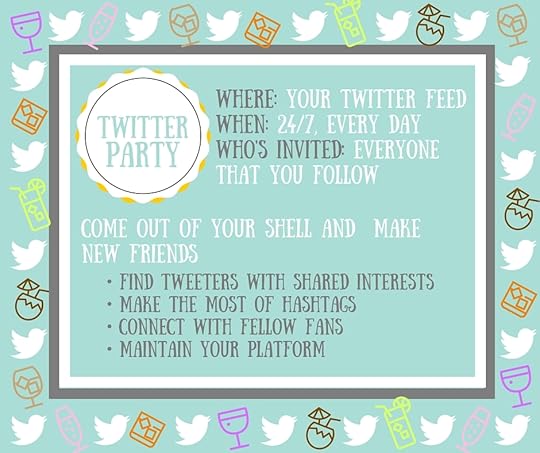
I find that it’s best to think of Twitter as a big cocktail party. People are milling around in groups usually based on their interests, political leanings, and sometimes based on whatever they’re trying to sell. They’re usually putting their best face forward, though occasionally some of them imbibe too much and/or put their feet in their mouths.
Then you, the writer, walk in. Your dress shoes are already pinching or rubbing your heels. You try to unobtrusively smooth down the slightly rumpled dress or sport coat that you fished out of the back of your closet when you heard that this was a party you just couldn't miss. You grab a drink from a passing waiter and look around for some friendly faces.
The first group you spot is made up of fellow writers; your critique group or some folks you met at a conference. You head on over and they greet you warmly. You spend some time chatting with them. Now if you’re an introvert like me, and so many other writers, your first inclination is to comfortably spend the rest of the party hanging with your writer pals. They’re nice folks after all.
The trouble with that is that you should be at this particular party to meet READERS. I think part of the reason so many writers tell me they don't get much out of Twitter, is that they're not being strategic about how they use it. That begins with who you follow and who follows you. It’s great talking to other writers but if that’s as far as you go, you’re not going to sell many books. You need to get out there and mingle.
But who in the millions of users on Twitter should you be talking to? This is where choosing who to follow becomes important. The best way to build a following on Twitter is to follow the people that you want to follow you. If you follow them, many people will follow you back automatically. Others might be more selective and check your bio or your tweets before deciding to follow. This is where that snappy bio will be important. If you can spark their interest, they’ll follow you.
Not all followers are created equal. The key to building the RIGHT Twitter following is to know your audience. You can search Twitter to find people based on key words in their bios. For example: if someone says in their bio that they are an avid reader, they’re probably worth following. You can also target people based on other factors.
Shared interestsSearch on topics related to what you write like your genre or subject matter. I write books about a Gaelic speaking folklorist in North Carolina. So, I search for people interested in Folklore, Gaelic, Scotland, and North Carolina. I also write historical fiction, so I look for people who are interested in American history.
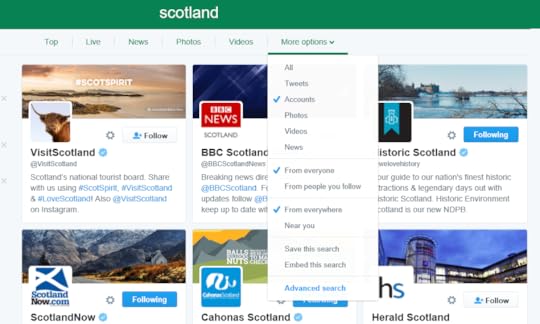
When you get your search results, change it to show the accounts related to these things by clicking on More options and choosing Accounts. Then follow those accounts that seem worth following. If you’re trying to connect with readers, you probably want to follow more people than media accounts, although some of those media accounts may have their uses too.
I doubt that writing is your only interest. So search out and follow folks who are interested in the same things that you are. Chances are, some of those people might be readers too. I’m a crafter, so I like to follow a lot of craft accounts. Fortunately for me, a lot of crafters are also readers.
HashtagsHashtags are another way of finding followers. They are a great way of connecting quickly to a particular conversation in twitter. By clicking on a hashtag, you can instantly see what people are saying about that subject. It can also show who is interested in that subject. You can search on hashtags just as you do on key words, or click on a hashtag when you see it to see WHO is talking about that particular thing.
You are probably familiar with writing related hashtags like #amwriting or #amediting, but you should also get familiar with hashtags about subjects that relate to your book or genre. In my case, #Gaelic, #folklore or #gothic. These can help you quickly find people who share your interests, and when you use these hashtags in your tweets, it will also help them find you.
Fellow FansAnother way to find readers and one that has helped me immensely, is to find people who are fans of the same writers that you like. Make friends with them. Don’t just tweet at them about your book, engage with them about the books that you enjoy. If you have written the type of book that you would like to read, odd are they would like it too. There is a reason why so many of my readers are also Outlander fans. It's not just I write about Scottish things. It's because I'm part of that tribe.
Also look for fans of writers who are similar to you. It’s lovely to think that all of us are special snowflakes in the literary world, but truth of it is that while each of our voices may be different, there are some of us who are similar to others. Whether it’s what you write about or your sub-genre or your writing style, there is someone out there who's not that different from you.
If you were to pitch to a publisher or agent, they would likely ask you for a comparable. As distasteful as that might be to some of us, it’s something that we all have to do. So, if I were to say that my book is like Southern Fried Susanna Kearsley or Outlander meets The DaVinci Code, I’m drawing a comparison to something that people are already familiar with. You can use that connection to find people to follow on Twitter. Find fans of writers that are similar to you, the more successful the better, and engage with them. With any luck they will follow back and begin listening to your conversation.
Maintaining your platformYou can’t build a good following overnight. It takes time, so if you're writing a book now, you should get started building that platform. You will probably encounter a lot of Tweeters who claim that for just $5 they can deliver you THOUSANDS of followers instantly. It’s honestly not worth the money. It’s much better to have a following that you have tailored to your audience than to have thousands of random and often fake accounts following you. This article gives some more great reasons why buying followers is a bad idea.
Once you have built a following, you’ll want to do some maintenance. About once a month, I use a tool like Crowdfire or Friend or Follow to identify accounts that may be dormant or aren’t following me back and unfollow as many as they allow for free.
Services like Crowdfire or Friend or Follow will let you pay to unlock more tools for managing your accounts. While all of those things might be helpful, and if you’ve got the cash to spend then go ahead. I would rather spend that money on advertising or editing services. I don’t pay for followers and I don’t pay a service. I just spend an hour or two a month managing my feed.
Next time we’ll talk about some of the DON’Ts of using Twitter for writers.
February 19, 2016
Thank you, Harper Lee
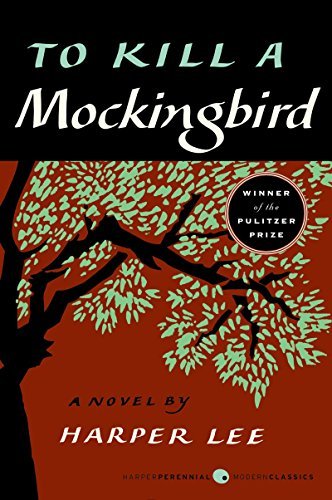
To Kill a Mockingbird (Harperperennial Modern Classics)
By Harper Lee
As a girl, I spent large chunks of my summer at my grandparents' houses in small towns in North Carolina. Wearing flip flops (if any shoes at all) and playing with my brother and cousins outside among the pine needles and cat tails and sandy soil. We weren't that different in those summers from the Finch kids. And when I read To Kill a Mockingbird as a teenager, I felt like it was written just for me; a book about a Southern girl barefoot and curious, starting to navigate the more complicated aspects of life.
As a white person from a comfortable family, Harper Lee's words taught me that racial equality and social justice are hard as hell to come by, but so worth fighting for even when everyone around us is pushing back or wondering why.
As a humanist, her book taught me to look for the good in everyone. No one is evil. No one is born bad. Good people can do bad things, because it's what they believe is right. And what a person believes is right can be a product of a lot of different factors. Likewise, she taught me that everyone, even the Boo Radleys of the world are capable of being heroes.
As a writer, she taught me the importance of voice and perspective, of putting yourself in the background. To Kill a Mockingbird would have been a wholly different book if it had been told through the eyes of Atticus or Dill or Boo. It's Scout that tells us the story, as only she can.
As a mother, she taught me to be patient with my own children, and also to give them room to be themselves, whoever they are. I try to give them the freedom to like what they like and embrace the things that they are curious about, and to teach them the same patience, tolerance, and passion for justice that Harper Lee taught me.
So, when my good-hearted son tells me he wants to be an attorney and work for justice, I embrace it. And when my ever-curious, ever-thinking daughter wants to read about dragons, dinosaurs, spiders or cats, or just play in the sandbox I say, "Go on Jean Louise, (Yes, I do sometimes call her that.) Just don't be late for dinner."
January 12, 2016
Our daughters are watching
The last time I worked in a corporate setting, I watched a man who was less qualified than I was get a job that I had applied for because one of his “bros” from a previous job put in a good word for him. After a couple of months of watching said underqualified man, flounder in his position, his boss had the gall to ask me to teach him the skills that he lacked. Skills that I had. Skills that were on my resume and the job description for the position that he had been hired for. Now, younger, worker bee, trying to get ahead me totally would have taken one for the team and waited things out like a good girl. Fortunately, I wasn’t that girl anymore.
...she has to be twice as smart, work twice as hard, and be twice as nice to get the same of recognition that a boy gets.
I refused. Within an hour of the conversation in which I was he asked me to teach the guy they had hired over me, I presented the boss with my exit plan. Fortunately, the boss was a good man who knew exactly why I was doing that and didn’t blame me a bit. I finished the project that I was working on (because I hate leaving things unfinished) and I left.
That was almost two years ago, and I have not regretted standing up for myself for a minute. I gave up some pretty substantial income, and on days when I wonder how I’m going to pay my editor for his work on Cauldron or Book 3, or when I want to travel more, I miss that. Still, when they contacted me six months later asking me to come back, I refused again. That time wasn’t because of any slight, but because I would rather spend all of my time working toward my dreams than someone else’s.
That experience taught me that standing up for yourself hurts sometimes, but in the end it’s worth it for our self-respect and for our daughters.
My daughter is nine years old, whip-smart and full of spunk. She’s also at the age when school starts to take a bit of work. She’s learning that she can’t get by on smarts alone. I find myself telling her in various tones of voice and at various volumes that she has to be twice as smart, work twice as hard, and be twice as nice to get the same of recognition that a boy gets.
I hate that I have to tell her this, but it’s true. I learned it in the corporate world. Unless you’re working in the rare fields that are dominated by women, most of us do. I even see it in my own family. Older relatives frequently comment about how smart my son is. When they talk about her, it’s not about how smart she is. It’s usually how funny she is or how cute she looks with her hair cut a certain way, never mind that she’s in multiple programs for gifted children.
While she’s brilliant, she’s also still a girl. She likes princesses and fashion just as much as the next girl. So, I was pleasantly surprised one day a couple of weeks ago when I heard her say something that brought tears to my eyes.
My husband has recently been bitten by the photography bug, and he was testing out a new lens by taking a few shots of our girl beside a window. When he made a comment to her about how pretty she looked, she said with complete conviction, “It’s not my job to look pretty, Dad. It’s my job to be totally awesome.”
‘Damn right, sister.’ I thought. Maybe some of what I’ve been telling her is sinking in. Maybe it’s the example of standing up for myself, and as my husband tells me to do every day, ‘kicking ass’. I’m sure it’s some combination of all those things, and I’m going to keep doing it. My daughter is watching.
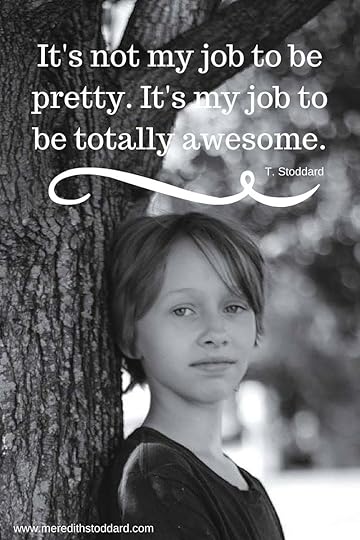
January 8, 2016
New Year Update
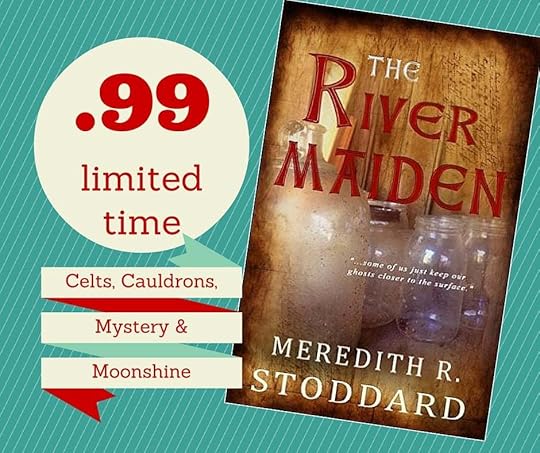
There are only a few hours left to get The River Maiden for .99! This is probably the last time that I will be discounting it before the pre-order period for Cauldron begins. Don't miss your chance.
I am making good headway on Cauldron, and seem to be on track for a late spring/early summer release. However, much of that will depend on my editor's schedule as well as mine. So, keep your fingers crossed.
I have also added a new page to the site. This is a gallery of Gaelic words and phrases with images or cards that I have made to help remember and teach them.
November 26, 2015
November 4, 2015
Because life sometimes

October is my favorite month because every year it seems to be busy with some of my favorite things; Celtic festivals, writer's conferences, birthdays and visiting friends. Plus leaves start turning, weather gets cooler and everything is great. This October however was NOT what I had hoped for.
Like a crazy person, I thought I had a chance of finishing a draft for Cauldron in October. I don't think there is that much left to write, and I was (and still am) looking forward to exorcising this particular plot from my brain. Unfortunately, this October it seemed that life was conspiring to thwart me.
The last couple of weeks have been particularly difficult. I told myself that I would come out of the James River Writer's Conference energized and ready to write my fingers off, which is usually the case. It almost happened. I was super excited when I got home on Sunday. Unfortunately, the very next day my daughter was diagnosed with a tree nut and peanut allergy. Of course this meant that instead of writing, I was cleaning out the pantry and researching how to keep my little evil genius in training from eating something that might cause a deadly allergic reaction.
For months now, writing progress has been slow. It's not writer's block exactly. It's more like pulling teeth. I've never been a fast writer. I'm not one of those who can tell myself that the first draft of everything is shit and just plonk down a thousand words of garbage in an hour. I wish I was. I have tried. I did NaNoWriMo last year, and wrote more than half of the book that I'm trying to finish now. But I'm just not wired to spew out words without caring about the quality. I know I can clean it up in revision, and I do. But for me to be excited about something as big as a novel long enough to finish it, I have to see it's potential.
After having to curtail writing for most of that week, I found myself desperately in need of a mental health day. I decided to take it last Monday. Then my mental health day turned into two sick days, where sinus issues knocked me flat. It took a lot of self-talk and a little encouragement from my husband to not hate myself for not writing those days. (Did I mention that my work ethic can sometimes be pathological?) That brought me to Thursday, where I took the journal that I write the Pip stories in with me to a cafe and was going to spend some quiet time working on that. Hoping that a little break from Cauldron would help get things rolling.
Then the school nurse called. First of all, the nurse at my daughter's school is AWESOME and proactive. She got an email about an epi-pen recall that applied to the pens that I had just bought the week before. So, the rest of that day was spent getting new epi-pens for her highness. Friday, I had my Gaelic class, and was just settling in to get back to writing when I got a text message from the local sheriff's office. A school bus had overturned.
After ten minutes of frantically texting and calling my son to no avail. Another message came through identifying the bus as his. You do not ever want to learn by text message that your child was in a serious accident. That bears repeating: You do not EVER want to learn by text message that your child was in a serious accident. Luckily, he wasn't seriously hurt. After an interminable ride through Friday afternoon traffic to find him at a hospital, I was toast, emotional toast. But I managed to keep it together, because he was clearly terrified.
He's fine now, and aside from being slightly phobic about riding the school bus again is just about back to normal. I on the other hand was not. I kept it together all weekend because kids and Halloween and visiting with family. But I admit, I find the occasional tears of relief spilling out when I least expect it; on the way to the grocery store Sunday when I was alone for the first time since Friday, going to the AT&T store to replace his phone that got smashed, any quiet moment when the kids aren't around.
So, there hasn't been much as much writing in the last couple of weeks as I had hoped. I'm trying very hard not to hate myself for that, as I am prone to do. But hey, it's November! NaNoWriMo did wonders for me last year. Maybe I'll at least try to hit it that hard this month until this draft is finally done. I CAN see the light at the end of the tunnel. Really.




